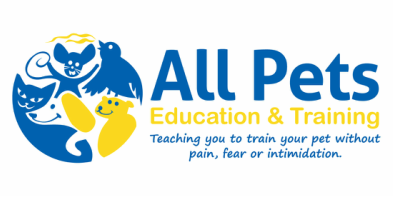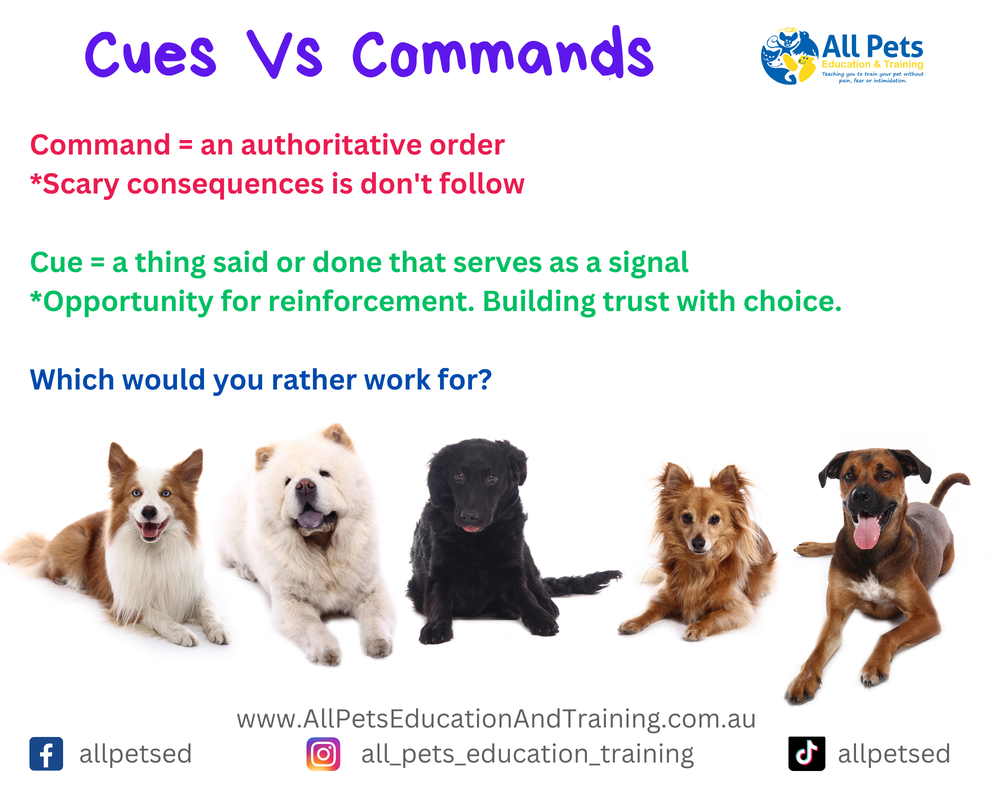Cues vs Commands
Which do you use?
In the animal training (especially dog training) world these two words “Command” and “Cue” are often used interchangeably.
However, I like to think of them as two different things, and I give my dogs’ cues and not commands.
Why?
Well first let’s look at the definition for each.
Command = an authoritative order
Cue = a thing said or done that serves as a signal
So when we think about it, a command is something directed to the dog and implies that there will be a consequence if they do not follow and the dog complies to avoid the consequence.
Whilst a cue is a signal or request to do something – implying your dog has choice and that they will be rewarded if they do.
Why do I allow my dogs choice? Well # 1 – it builds trust. An animal that trust you will actually do a lot more for you, consenting and without stress.
Think about Koffi my old girl now passed. We were able to take her blood using a sustained target. If she broke the target, I would stop doing what I was doing – she had choice. It gave her confidence and she was comfortable that she could choose to have a break, before re-engagement with the target, signaling her consent to go ahead. And of course she has payment at the end.
What is an example of a Cue vs Command in our world as responsible adults?
Imagine this scenario
I’m driving along (in Aus so on the left side of the road), a car coming in the opposite direction has his right hand indicator on – this cue signals to me, that this car is wanting to turn right – potentially across my lane.
What does this mean? Does it mean that I have to do something? No, however, it does make me aware, I may see the car, and continue on my way because traffic ahead is clear and flowing, or I could see the car, look ahead, see that traffic is slowing and banking up, and stop back from the intersection to allow the car to join or cross my lane.
However, imagine, now that I’m driving along, and suddenly I have the red and blue lights and sirens of a police car behind me. Is this a cue (do I have a choice), or a command to pull over. Will there be consequences if I ignore the police car? Yes.
In our world there are many things that act as cues for our dogs. It could be the gate click that cues the dog to go to the door to greet you when you arrive home from work. It could be the opening of a fridge door, which cues your dog you are about to do their dinner prep.
It can be body positions (hand signals etc), or verbal cues that request your dog to do something such as “sit”.
What happens if your dog doesn’t follow the request of your cue – they don’t get paid, no payment is made in pats, play, praise, leash on for walks or food etc.
Why may your dog not follow such a request?
· Do they really know the behaviour?
· Has it been generalised?
· Are they uncomfortable - Pain is a big thing to consider for many pets.
· Stressed or Over threshold
· Feeling ill or tired
What happens if your dog doesn’t follow a command? In traditional dog training classes this results in something aversive such as a collar jerk, leash pop, pressure, static pulse etc.
Would you rather work for cues or commands? Which do you use in your training?
However, I like to think of them as two different things, and I give my dogs’ cues and not commands.
Why?
Well first let’s look at the definition for each.
Command = an authoritative order
Cue = a thing said or done that serves as a signal
So when we think about it, a command is something directed to the dog and implies that there will be a consequence if they do not follow and the dog complies to avoid the consequence.
Whilst a cue is a signal or request to do something – implying your dog has choice and that they will be rewarded if they do.
Why do I allow my dogs choice? Well # 1 – it builds trust. An animal that trust you will actually do a lot more for you, consenting and without stress.
Think about Koffi my old girl now passed. We were able to take her blood using a sustained target. If she broke the target, I would stop doing what I was doing – she had choice. It gave her confidence and she was comfortable that she could choose to have a break, before re-engagement with the target, signaling her consent to go ahead. And of course she has payment at the end.
What is an example of a Cue vs Command in our world as responsible adults?
Imagine this scenario
I’m driving along (in Aus so on the left side of the road), a car coming in the opposite direction has his right hand indicator on – this cue signals to me, that this car is wanting to turn right – potentially across my lane.
What does this mean? Does it mean that I have to do something? No, however, it does make me aware, I may see the car, and continue on my way because traffic ahead is clear and flowing, or I could see the car, look ahead, see that traffic is slowing and banking up, and stop back from the intersection to allow the car to join or cross my lane.
However, imagine, now that I’m driving along, and suddenly I have the red and blue lights and sirens of a police car behind me. Is this a cue (do I have a choice), or a command to pull over. Will there be consequences if I ignore the police car? Yes.
In our world there are many things that act as cues for our dogs. It could be the gate click that cues the dog to go to the door to greet you when you arrive home from work. It could be the opening of a fridge door, which cues your dog you are about to do their dinner prep.
It can be body positions (hand signals etc), or verbal cues that request your dog to do something such as “sit”.
What happens if your dog doesn’t follow the request of your cue – they don’t get paid, no payment is made in pats, play, praise, leash on for walks or food etc.
Why may your dog not follow such a request?
· Do they really know the behaviour?
· Has it been generalised?
· Are they uncomfortable - Pain is a big thing to consider for many pets.
· Stressed or Over threshold
· Feeling ill or tired
What happens if your dog doesn’t follow a command? In traditional dog training classes this results in something aversive such as a collar jerk, leash pop, pressure, static pulse etc.
Would you rather work for cues or commands? Which do you use in your training?

